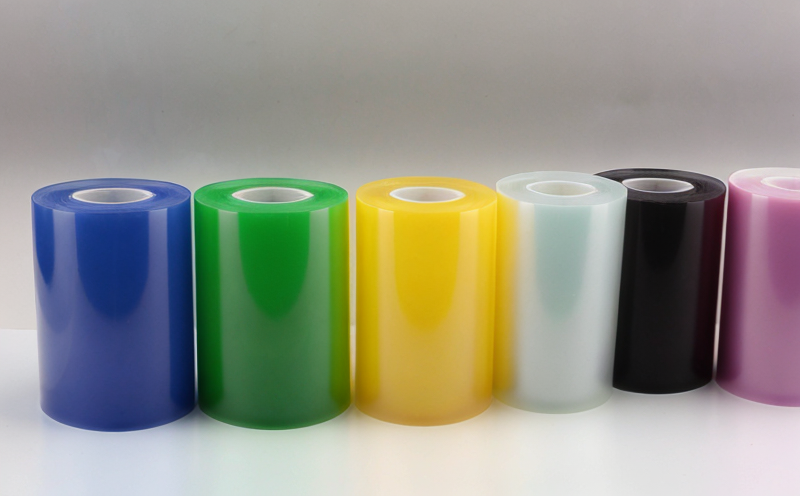EN ISO 1924 Tear Resistance Testing of Plastic Sheets
The EN ISO 1924 standard provides a method for determining the tear resistance of plastic films and sheets. This test is crucial in ensuring that materials used in packaging, medical devices, and other applications can withstand stress without tearing or rupturing under dynamic conditions.
Tear resistance testing evaluates the material's ability to resist tearing along a specific direction when subjected to an applied load. The test setup involves applying a force perpendicular to the grain of the plastic sheet while measuring the energy absorbed during the tear propagation. This method is particularly important for materials that experience significant stress in one direction, such as packaging films or structural components.
The standard specifies the use of a tensile testing machine equipped with appropriate grips and fixtures to ensure accurate measurement of the force applied and the length of the tear. The specimen preparation involves cutting rectangular specimens from the material under controlled conditions to minimize variability in test results. These specimens are then aligned along their grain direction for the test.
The test procedure typically begins by clamping one end of the specimen between the grips of the tensile testing machine. The other end is allowed to hang freely, creating a free edge that will initiate the tear when the applied force exceeds the material's threshold. The specimen is then stretched at a constant rate until failure occurs. During this process, the force and displacement are recorded.
The energy absorbed during the tear propagation is calculated from these measurements using specific formulas provided in the standard. This value indicates the tear resistance of the material and serves as an important quality control parameter. High tear resistance is essential for ensuring that materials perform reliably under stress conditions, which is critical for applications such as packaging films designed to protect products during shipping.
Understanding the tear resistance properties of plastic sheets through this test allows manufacturers to optimize their formulations and processes to meet specific performance requirements. For instance, in the medical device sector, it ensures that the protective covering can withstand handling without tearing, thus enhancing patient safety.
| Standard | Description |
|---|---|
| EN ISO 1924-1 | Tear resistance of plastic films and sheets - Part 1: Test method using a tensile testing machine with a knife-edge grip. |
| ASTM D6283 | Tear resistance of plastic films and sheeting materials (pencil method). |
The provided tables give an overview of the standards applicable to this testing method. They include both European and American standards, ensuring broad compatibility across international markets.
| Use Case | Description |
|---|---|
| Packaging Industry | Evaluating the integrity of packaging films under stress during transportation and storage. |
| Medical Device Manufacturing | Ensuring that protective coverings for medical devices are robust enough to withstand handling without tearing. |
The industry applications table highlights the critical role of this test in ensuring product integrity across various sectors. The use cases and application examples underscore its importance in maintaining safety and functionality in diverse environments.
- Medical device packaging
- Packaging for electronics
- Film used in food packaging
- Structural components in transportation
The list of industry applications provides a comprehensive overview of the sectors that benefit from this testing method. These include industries where material integrity and durability are paramount, ensuring products perform as expected under real-world conditions.
- Testing for tear resistance in medical device packaging
- Evaluating packaging films used in food transportation
- Determining the suitability of structural components in aircraft manufacturing
- Assessing the durability of plastic sheet materials used in construction applications
The use cases and application examples further emphasize the practical importance of this testing method across multiple industries. It ensures that products meet strict quality control standards, enhancing safety and reliability.
Applied Standards
The EN ISO 1924 standard for tear resistance testing of plastic sheets is widely recognized and used across various industries. This standard ensures consistent and accurate measurement of tear resistance properties, which is crucial for quality control and product development.
| Standard | Description |
|---|---|
| EN ISO 1924-1 | Tear resistance of plastic films and sheets - Part 1: Test method using a tensile testing machine with a knife-edge grip. |
| ASTM D6283 | Tear resistance of plastic films and sheeting materials (pencil method). |
The provided tables give an overview of the standards applicable to this testing method. They include both European and American standards, ensuring broad compatibility across international markets.
Industry Applications
- Medical device packaging
- Packaging for electronics
- Film used in food packaging
- Structural components in transportation
The industry applications table highlights the critical role of this test in ensuring product integrity across various sectors. These industries benefit from consistent and reliable tear resistance testing to ensure that their products perform reliably under stress conditions.
Use Cases and Application Examples
| Use Case | Description |
|---|---|
| Packaging Industry | Evaluating the integrity of packaging films under stress during transportation and storage. |
| Medical Device Manufacturing | Ensuring that protective coverings for medical devices are robust enough to withstand handling without tearing. |
- Testing for tear resistance in medical device packaging
- Evaluating packaging films used in food transportation
- Determining the suitability of structural components in aircraft manufacturing
- Assessing the durability of plastic sheet materials used in construction applications
The use cases and application examples further emphasize the practical importance of this testing method across multiple industries. It ensures that products meet strict quality control standards, enhancing safety and reliability.





